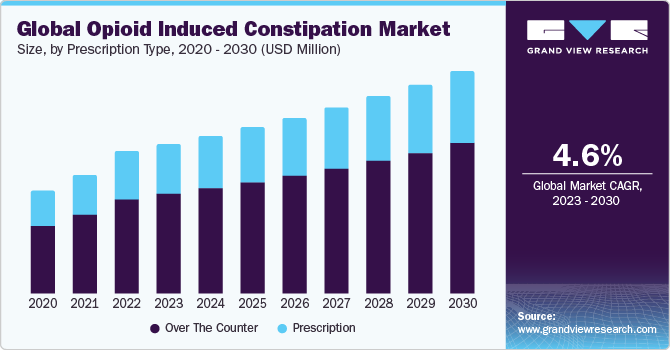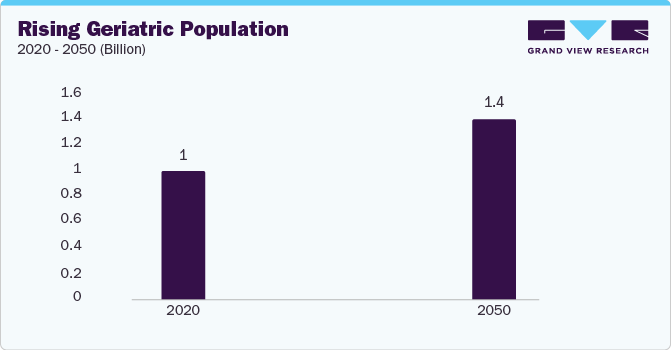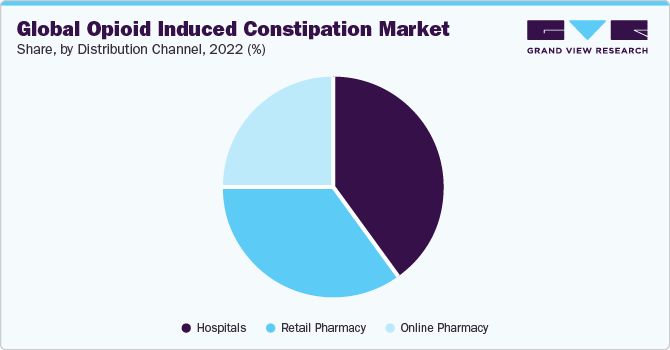Opioid Induced Constipation Market Trends
The global opioid induced constipation market is anticipated to experience a compound annual growth rate (CAGR) of 4.6% from 2023 to 2030. The primary driver of this growth is the increasing number of geriatric patients who are prescribed opioid analgesics, such as morphine, hydromorphone, codeine, etc., for the treatment of chronic non-cancer pain. There is a high demand for solutions within this market due to the significant digestive system side effects associated with these drugs.

With improved healthcare infrastructure availability, an increase in the prevalence of chronic pain cases in adults, and rising unmet healthcare needs, there's a heightened demand for novel drugs, especially for the management of OIC. Emerging countries are expected to drive the growth of the OIC drugs market. Furthermore, the demand for substantial government investments to enhance healthcare infrastructure, provide better healthcare services, and promote medical tourism in emerging nations is contributing significantly to the growth of the healthcare sector in these economies.
The primary factor driving the market's growth is the rise in the number of adults who have been prescribed opioid analgesics such as morphine, hydromorphone, codeine, etc., for the treatment of chronic non-cancer pain. According to the Centers for Disease Control and Prevention (CDC), in November 2021, the number of OIC prescriptions climbed by 153,260,450 in 2019 and 142,816,781 in 2020. The increasing number of patients using opioids necessitates effective treatment for OIC conditions, which is expected to drive the demand for opioid-induced constipation over the forecast period.
Prescription Type Insights
Based on prescription type, the opioid-induced constipation market is segmented into over-the-counter (OTC) and prescription medications. The prescription segment is expected to dominate the market over the forecast period. This dominance is attributed to the fact that prescription drugs are often required due to their higher efficacy and potency compared to over-the-counter alternatives.

Drug Class Insights
Based on drug class, the market is segmented into chloride channel-2 activators, mu-opioid receptor antagonists, and others. The mu-opioid receptor antagonists segment dominated the market in 2023. This dominance is driven by the availability of various product types introduced by major manufacturers that are suitable for different OIC symptoms, as well as the increase in research activities in the market. Medications such as Methylnaltrexone (Relistor), Naldemedine (Symproic), Naloxegol (Movantik), and Alvimopan (Entereg) are readily accessible in the market for OIC indications.
Distribution Channel Insights
Based on the distribution channel, the opioid-induced constipation market is segmented into hospitals, retail pharmacies, and online pharmacies. Opioids are frequently used in hospitals to treat pain, a factor that can lead to constipation in patients. A variety of drugs and therapies may be employed to manage this condition. The prevalence of opioid usage in clinical settings and the accessibility of therapies are two factors that contribute to hospitals' dominance in this industry. The higher number of patients with cardiovascular and lipid-related conditions may result in increased hospital admissions, thereby driving the demand for fibrate drugs in hospital settings. Additionally, hospitals may collaborate with pharmaceutical companies to ensure a steady supply of fibrate drugs and gain access to clinical trials or special formulations.

Regional Insights
North America accounted for the largest market share in 2023. This dominance is attributed to the rising incidence of several gastrointestinal (GI) illnesses among older patients in the U.S. and a significant increase in opioid use in Canada over recent years. For instance, according to the Centers for Disease Control and Prevention's (CDC) update in November 2021, 43.3 opioid prescriptions were written for every 100 people in the U.S. in 2020. The market is expected to experience growth over the forecast period due to an increase in OIC prescriptions in the U.S.
Key Companies & Market Share Insights
Key players operating in the market include Takeda Pharmaceutical, AstraZeneca plc, Bausch Health (Salix Pharmaceuticals), Mallinckrodt Pharmaceuticals, Merck & Co Inc, RedHill Biopharma, GlaxoSmithKline (Theravance Biopharma Inc), Shionogi & Co Ltd, and Novartis AG (Sandoz). These market participants are constantly working towards new product development, engaging in M&A activities, and forming other strategic alliances to explore new market avenues. In January 2022, BioGaia Pharma reported the first enrollment of a patient for the phase II clinical study of opioid-induced constipation (OIC-1).














